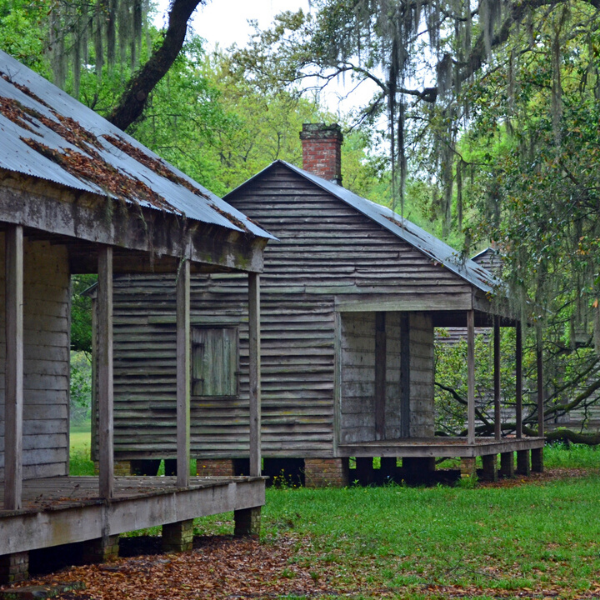The Slave Village at Evergreen Plantation
This cabin is one of 22 cabins that exist from the time of slavery on this plantation. While thousands upon thousands of these buildings once existed across the American South, they are now exceedingly rare. This is the only place where they exist unchanged. The cabins have been repaired over the years and in the last twenty years have been stabilized by the present owner to assure they remain to tell their story.
This row layout of slave cabins is one of several forms for slave villages. It is referred to as double row, double pen and originated in Haiti. It is the common form in this part of Louisiana. According to our records and to published accounts of slave housing in St. John Parish, 4 or 5 people would have lived in this cabin. Our records show that if a family lived in this cabin, they would have had the whole cabin and lived and eaten in a family unit. Archeology studies here show: garden row compressions behind each cabin, compressions indicating poles for kitchen buildings and animal pens, posts for fences, and cisterns on all 4 corners of each building and outhouses in the back of each house. Records indicate that except for grinding season , October, November, and December, slaves worked 6 days a week with Sunday off. They probably sold surplus crops at the plantation store. Records in St. John indicate that in the French and Spanish periods of Louisiana history, slaves were able to accumulate money and buy themselves and other family members out of slavery. After 1803, this becomes more and more difficult because of the different laws governing slavery in the United States that came to this area with the Louisiana Purchase.
The Village after the Civil War
After the Civil War, many former slaves either stayed or returned to the plantation to work in the fields, this was their only option if they were to remain in this area. Many of the English speaking slaves went North after the war hoping for better conditions and looking for family members. The French speakers, at least half of this group of former slaves, would have remained simply because of the difference in culture and language. Life on the plantation for these “free” people would have been very difficult. All of their hoped for dreams of freedom and equality would have just remained a dream. Re-establishing a profitable plantation in the war torn South was a struggle and resulted in very little pay and worse living conditions than they lived under before the war. As the plantations were rebuilt to their former glory, very little changed in the Quarters Village. To help you understand this, imagine living in these cabins in the 1940s, possibly a dozen or more people to a cabin, with no water or electricity. These were the conditions in the Quarters when the present owner bought the plantation in the late 40s. At that time, the hourly wage was raised and living quarters were no longer a part of field pay . Evergreen was the last Quarters village standing and Ms. Gray understood the historical significance of the village and restored and protected the village along with the big house and it's dependencies. It is this village that prompted the National Historic Landmark designation for Evergreen. This small cabin in front of you has equal importance to the “Big House” at Evergreen and to Mount Vernon in Virginia. It is one of the buildings listed on the National Register of Historic Places, the highest honor our country bestows on a building.
